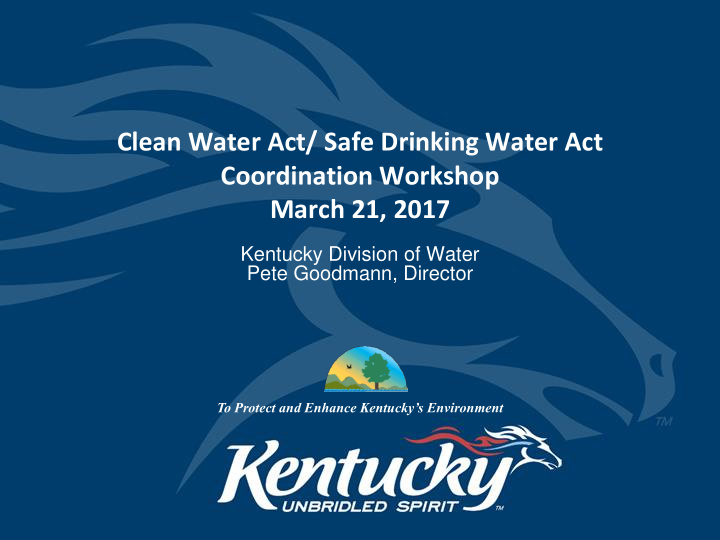



Clean Water Act/ Safe Drinking Water Act Coordination Workshop March 21, 2017 Kentucky Division of Water Pete Goodmann, Director To Protect and Enhance Kentucky’s Environment
Drinking Water – Reliable & Sustainable • How do we ensure safe, reliable, sustainable, and resilient drinking water – 97% of Kentucky residents supplied by public water – Funding the maintenance of existing infrastructure – Small systems (consolidation opportunities, enhance TMF and operator capacity, …) – Ensure sufficient, high quality source water 2
Kentucky Source Water Protection Program • 1 st SWAPP approved by EPA – Form versus Function • DOW determined to use what we had in place and get ahead of what EPA wanted • Good – Good delineation methodologies – Integrated GIS/data management • Problems – Static exercise – Not collaborative with stakeholders – Not integrated across programs 3
Challenges to Collaboration • Organizational • Leadership! • Cultural – SDWA, CWA programs have unique cultures – Developing partnerships b/w programs depends on • Understanding extent of Authorities and Resources • Personal Relationships • Funding: creatively seeking smart approaches – DWSRF set asides, FEMA HMGP, CWA §106 supp., RCPP, P3, Private Foundation, etc. 4
Innovative Practices: Monitoring • Focus monitoring to evaluate source waters for drinking water use and treatment challenges • HABs/algal toxins: has become a regular commitment • Focus on susceptible/recurrent waters w/ flexibility • Re-thinking lakes assessments? What is proper approach to assessment • 304(a) criteria for algal toxins) • Challenges: competes with traditional monitoring/assessment • Ambient, Probabilistic, Lakes, Fish Tissue, Reference Reach 5
Volunteer Monitoring • Refocusing volunteer monitoring to Source Waters – Natural constituency of volunteers that live on lakes – Potential for support from local PWS, Community, P3 partnerships • Local businesses have inherent interest – Subsidized by agency (e.g. data management, technical assistance, logistics, supplies) 6
Volunteer Lake Monitoring Program • Use Volunteers to expand lake monitoring efforts • Simple field tests • Secchi Depth measurements; • Visual observations: emphasis on HAB and reporting • Goal 1: Provide opportunities for citizen scientist to research local water bodies • Goal 2: Generate accessible, quality data to characterize water quality • Goal 3: Augment DOW lake monitoring conducted 7
Re-imagining Source Water Protection: ORSANCO • Integrating Source Water Protection through system-scale data management and communication Ex. Working with NKWD, Cincinnati Water Works, and ORSANCO to develop a Ohio River systemic source water approach – GIS, Data Management, Sentry Monitoring (ODS) 8
TMDLs • Focusing TMDL development on impaired source waters/watersheds – Particularly for nutrient-impaired and HAB-impaired water bodies (generally lakes) • Requires significant water quality and land-use data • Focuses on permitting solutions • Identifies and provide goals for non-permitted, NPS activities and land uses 9
Permitting • Focusing permitting in source water/watersheds on protections for nutrients, TOCs, other precursors/ pollutants of concern • Require monitoring of receiving waters for POC? • Provide incentives and tools for watershed-scale reduction of nutrients from both point and non-point sources 10
Re-imagining AWOP • Traditionally addressed turbidity to reduce risks to public health • Focusing on DBPs • Using same efforts to address specific source water treatment challenges – HABs, TOC, Turbidity… – Looking at methods outside the WTP • Monitoring, Source Water treatment… 11
Preserving High Quality Source Waters • Identify using available data and new tools: – Monitoring data – Recovery Potential Screening Tool • Preserving high quality waters is more cost effective that restoring impaired waters – Controlling land use via easements, restrictions, mandatory water quality plans, AWQ plans, NMPs 12
Integrated Infrastructure Planning • Regionalization of water and prioritizing preferred source waters • Sewer priority areas (e.g. residential development around lakes) • Dam design, maintenance and upgrades 13
Source Water Assistance Program • Mini-Grants for Source Water Protection – Uses DWSRF Set-Asides • Short-term 1-year “ shovel ready ” projects directly linked to source water protection – High likelihood of implementation – $150k/year; limit $60k/project • PWS, municipals, water/conservation districts, local governments, associations, educational institutions, 501 (c)(3) organizations 14
Contact Pete Goodmann, Director Division of Water 300 Sower Blvd. Frankfort, KY 502-782-6956 (direct line) Peter.Goodmann@ky.gov
Recommend
More recommend